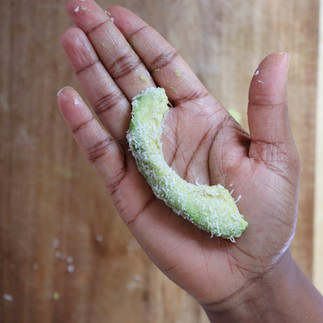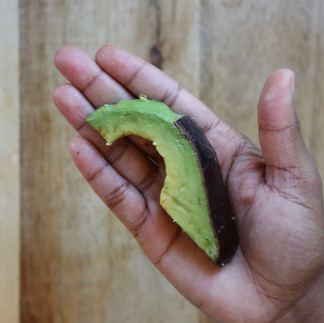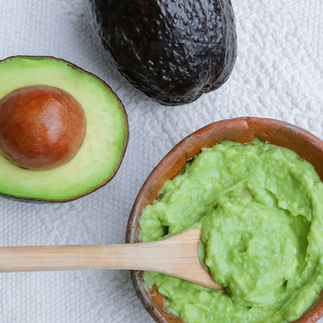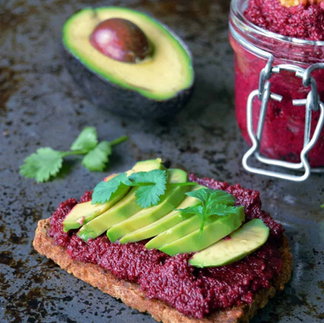AVOCADOS | 6 mos+ |🥇🔥🌈
- Priscila Cleary

- Nov 9, 2021
- 8 min read
Updated: Apr 16, 2024

Avocado is a great first food for babies! It is an excellent source of "good" fats that are important nutrients for baby’s brain and physical development. Another great thing about avocados is that they are easy to take with you. Just grab a spoon - shove an avocado in your bag, and you have instant baby food.
DISCLAIMER: Each child has their own development timeline and specific needs. The content below is general information and for educational purposes only and is not a substitute for professional one-on-one advice. You are responsible for supervising your child’s health and for evaluating the appropriateness of the information below for your child. Please consult your healthcare provider regarding support or advice for your child's well being and health. Never disregard professional medical advice or delay in seeking it because of something you have read or seen here.
Contents
When can I give avocado to my baby?
Babies can eat avocados as soon as they are ready to start eating solid foods, which is usually when they are around 6 months of age and have met all the readiness signs for solids, unless otherwise advised by your baby's health care provider.
You can give your baby a safe start to solid foods! This on-demand workshop will provide you with the knowledge and confidence you need to wean well.
Is avocado a healthy food for babies?
Avocado is a great first food for babies! It is an excellent source of "good" fats that are important nutrients for baby’s brain and physical development. Another great thing about avocados is that they are easy to take with you. Just grab a spoon - shove an avocado in your bag, and you have instant baby food.
In addition to providing good fats for brain development, avocados are high in B-vitamins, vitamin A, vitamins C and K, folate, magnesium, potassium, copper, and fiber.
Avocado contains more folic acid (also called folate or vitamin B9) than many other fruits. Folic acid is essential for the healthy development of the nervous system, including cognitive abilities of the brain.
Avocados contain several micronutrients and vitamins. The fruit is rich in vitamin B6 that is vital for maintaining healthy immunity, which helps protect your baby from several diseases.
Avocado is also rich in antioxidants lutein and zeaxanthin that are stored in the eyes and improve vision.
Is avocado a safe food for babies?
In 2018, the FDA issued a report in 2018 saying that they found that Listeria monocytogenes, dangerous bacteria, was present on the skin of 17 percent of the avocados. Less than 1 percent tested positive for Listeria inside the avocado.
Listeria is a bacterium that causes listeriosis, an infection that mainly affects pregnant women, children, older adults, and those with weakened immune systems.
The FDA recommends that consumers scrub the outside of the avocado with a produce brush and dry it with a clean cloth or paper towel to reduce the number of bacteria that may be present. This can also be done with other “hard skin” produce, such as melons and oranges.
Is avocado a choking hazard for babies?
Avocados are not listed on CDC's list of most common choking hazards for babies. But to be safely offered to your baby, it needs to be ripe. Refer to the section “How to buy” below to learn more about how to choose avocados for baby.
This workshop covers everything you need to know for dealing with gagging, reducing the risk of choking during mealtimes, and offering safe food sizes and shapes to your child.
Note: Keep in mind that any food can present a risk for choking if not prepared correctly. You are responsible for following age and food modification guidelines provided in order to reduce your baby’s risk for choking.
Is avocado a top food allergen for babies?
Allergy to avocados is not very common. However, those who have Oral Allergy Syndrome (OAS; AKA pollen-food allergy) may have reactions to avocado. OAS occurs when a person sensitive/allergic to pollen develops a reaction to fruits/veggies that have a similar type of pollen. Itching & swelling of the lips, the mouth and/or throat are typical symptoms. These symptoms normally appear within minutes of eating the offending food and may be worse during the spring and fall pollen seasons. Rarely is an OAS life threatening.
Whenever you give your baby avocados (or other foods) for the first time, offer it in small quantities, and watch for any signs of a reaction. If your baby seems to tolerate the food well and you see no adverse reaction, then continue to gradually increase portion sizes when you offer it again to your baby. If your baby shows any symptoms like diarrhea, skin hives, abdominal pain, shortness of breath, swelling of mouth, weakness, or dizziness after the consumption of avocados, consult your healthcare provider. These symptoms can be a sign of avocado allergy or intolerance.
Note: Always consult with your healthcare provider regarding introducing solid foods to your baby, and specifically discuss any foods that may pose allergy risks for your baby.
How to buy avocados for babies
Look for ones that have no blemishes and that are not too soft to the touch. The harder it is the longer it will take to ripen, but avocados ripen well on your kitchen counter. Avocados are ripe when they feel soft (but not too soft or mushy, as it can be a sign that the avocado is spoiled, so be careful when purchasing them).
★ If you need a hard unripe avocado to ripen quickly, place it in a brown paper bag with a banana, which will release ethylene gas that speeds up the ripening process.
When are Avocados in Season?
Avocados can be bought pretty much all year round in the store. It’s in season during Spring, Summer, and Winter.
★In-season produce is fresher and tastes better, sweeter and perfectly ripe. They also tend to cost less compared to out-of-season produce. Seasonal produce in your area will vary by growing conditions and weather.
How to store avocados
Wrap a leftover avocado to keep it from getting brown. You can also add lemon juice to preserve an opened avocado. Like bananas, avocado is a fruit that you can buy early in the week and then use later on. If your avocado becomes soft before you want to eat it, just refrigerate it until you are ready. It will keep up to a week in the fridge, if uncut.
How prepare and offer avocado to babies

To safely prepare and offer an avocado to your baby, first make sure avocado is ripe, then peel the fruit and remove the pit. You may choose to leave some part of the skin to aid baby’s grip. If you do so, make sure you expose some of the avocado's flesh so baby can bring that part without the skin to their mouth (see picture above). Most babies are pretty good differentiating skin from the fruit’s flesh and tend to spit the skin out.
Purees: mashed on a pre-loaded spoon or via spoon feeding. You can also mash avocado with a fork in a small bowl, add formula, water or breast milk to make it less thick, if you desire.
6+ months: mashed or puree on a baby spoon

Baby Z, 6 months, eating mashed avocado
Don't get stuck on purees! It's completely ok to start with only pureed foods, if that feels more comfortable to you. However, keep in mind that purees are just a transitional phase into finger foods. It shouldn't last for more than a few days or a couple of weeks. Aim to start exposing your baby to lumpy and finger foods no later than 8 months, unless otherwise advised by your baby's health care provider.
Finger food 6 to 9 months old: At this age babies are only able to grab food with their whole palm, so you can offer avocado as a finger food by mashing the avocado and serving it on a baby spoon, or quarter avocado and offer slices to your baby by holding it in the air in front of them, by placing on baby’s hand, or by placing it on baby’s tray. This encourages self-feeding.
If offering the avocado without any peel, to make it less slippery you can coat the pieces in plain breadcrumbs, ground nuts, baby cereal (avoid rice cereal), hemp or chia seeds, or dried coconut flakes, so baby can have a better grip of the fruit. Just beware that wheat and nuts are part of the Big 8, the group of foods that account for about 90% of all food allergies in the United States. If you're offering those foods for the first or second time, it's better to offer them by itself, and it would be wise to start off in very small quantities. You can also cut avocado with a crinkle cutter to reduce slipperiness.
6+ months: coated slices, slices cut with a crinkle cutter, or slices with some skin to aid baby's grip
Baby Z, 6 months, eating avocado slices with some skin to aid baby's grip
Baby L, 6 months, eating avocado slices
Baby William, 6 months, eating avocado for the first time
Finger food 9 to 12 months old: At this age your baby will begin to use the pincer grasp (thumb and index finger) to pick up small pieces of food. So now you can move to smaller sizes of food. Offer bite-size pieces of avocado about the size of a garbanzo bean. You can still coat pieces as suggested above to aid grip.
9+ months: diced into bite sized pieces about the size of a garbanzo bean

Baby L, 10 months, eating an avocado popsicle
Finger food 12+ months old: Continue to serve bite-size pieces of avocado and incorporate into preparations as well. Continue to encourage the use of utensils. Once your baby masters the use of a spoon you can offer "avocado boats" by cutting the avocado in half, removing the pit, and offering it to baby with a spoon they can use to scoop the avocado flesh independently. Or you can offer avocado dips, like guacamole, and let them dip the spoon in it and bring it to their mouth.
Note: Finger foods are small pieces of food that your baby can pick up and eat easily. Introducing finger foods early, as soon as starting solids, helps your baby get used to different food textures, improves coordination and encourages self-feeding. These are important feeding skills. Babies can enjoy soft finger foods before they have teeth. They can mash foods into smaller pieces using their gums.
⚠️Avoid putting finger foods or whole foods in your baby's mouth for them. Your baby must do this at their own pace and under their own control.⚠️
Avocado meal ideas for babies:
Mash a nice, ripe avocado and offer it as a dip to accompany veggies or fruits.
Mash it thoroughly and spread it straight on to a lightly toasted bread strips.
Add diced avocado to scrambled eggs and give to your baby in a bowl to eat with his fingers.
Recipes
As always, discuss any concerns with your healthcare provider. This post and this site is not meant to be a substitute for medical advice. The materials and services provided by this site are for informational purposes only.
Library Symbol Legend
Here in our Food Library we use some symbols or emojis to make it easier for you to find what you need. Listed below are the symbols we use and what they mean.
🔥 - this is a high-calorie food. You should include a high-calorie food at each meal.
💪 - this is an iron-rich food. You should include an iron-rich food at each meal.
🌈 - this is a colorful food. You should include a fruit and/or a vegetable at each meal.
🥇 - this food is a great choice for baby's first food.
🌱 - this food is a great choice for plant-based babies.
💩 - this is a food that helps prevent or treat constipation.
🥜 - this food contains peanuts, a common food allergen.
🍳 - this food contains egg, a common food allergen.
🐄 - this food contains cow's milk, a common food allergen.
🌾 - this food contains wheat, a common food allergen.
✳️ - this food contains soy, a common food allergen.
💮 - this food contains sesame seed, a common food allergen.
🌰 - this food contains tree nuts, a common food allergen.
🐠 - this food contains fish, a common food allergen.
🍤 - this food contains shellfish, a common food allergen.
⚠️ - this food is a common choking hazard. Make sure to follow age and preparation guidelines.
★ - tips, tricks, and hacks.
References
Center for Food Safety and Applied Nutrition. (2018, December 7). FDA Releases Reports on Avocado and Hot Pepper Sampling. U.S. Food and Drug Administration. https://www.fda.gov/food/cfsan-constituent-updates/fda-releases-reports-avocado-and-hot-pepper-sampling
Avocados are Packed with Nutrients for Your Health. (2015, January 9). Healthy UNH. https://www.unh.edu/healthyunh/blog/nutrition/2014/12/avocados-are-packed-nutrients-your-health
Comerford, K., Ayoob, K., Murray, R., & Atkinson, S. (2016). The Role of Avocados in Complementary and Transitional Feeding. Nutrients, 8(5), 316. https://doi.org/10.3390/nu8050316
Hass Avocados. (n.d.). Specialtyproduce. Retrieved May 4, 2021, from https://specialtyproduce.com/produce/avocados/hass_949.php
The Amazing Avocado. (n.d.). Bastyr University. Retrieved May 4, 2021, from https://bastyr.edu/news/health-tips/2011/09/amazing-avocado#gsc.tab=0
Avocados | Food Source Information. (2020, October 23). Fsi.Colostate.Edu. https://fsi.colostate.edu/avocados/
Avocado Nutritional Information - Health Benefits of Avocado. (2021, March 19). Love One Today®. https://loveonetoday.com/
.png)





















.png)
.png)
Comments